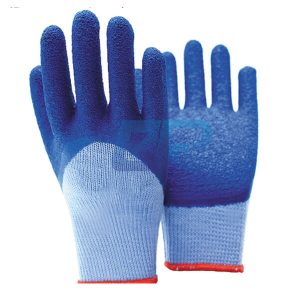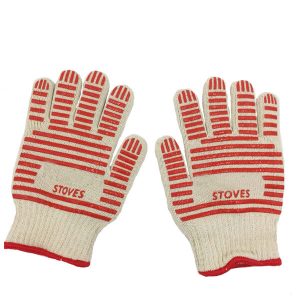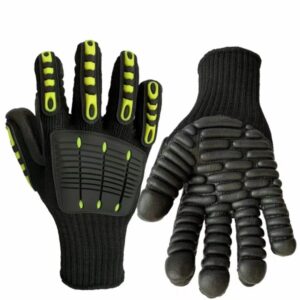When you work in the construction industry, work gloves for construction will be an indispensable piece of protective equipment for you. They act as a second skin for your hands, providing vital protection to ensure that you can work safely and efficiently in a variety of complex and potentially dangerous environments.
So, there are many types of work gloves for construction to choose from, so which are the best ones? How would you go about choosing work gloves for yourself or your employees?
First of all, what kind of work do you do when you are on a construction site?
When you work on a construction site you will be exposed to a variety of different jobs, each of which comes with its own unique risk of hand injury. How much do you know about the types of construction jobs and their hand injury risks?
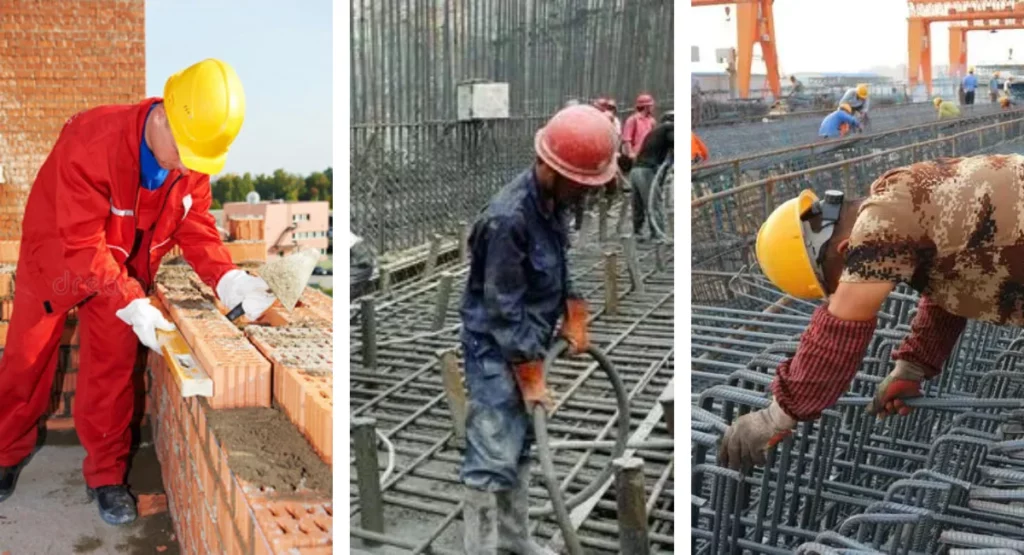
1. Mason/Bricklayer: As a mason or bricklayer, your day-to-day work involves handling cement, sand, and various building materials, laying bricks or tiles, or if you are involved in stone masonry, you are a stonemason.
Related Injuries:
- Lifting Injuries: when lifting these materials, especially heavy ones, it is easy to sprain or strain your hand if you are not in the right position or are too impatient.
- Cutting Risks: When using cutting tools such as brick cutters, chainsaws, etc., a single slip can lead to cutting injuries to the hands, and in severe cases, even to the tendons and bones.
- Long-term strain: Repetitive hand labor over a long period may also lead to chronic muscle fatigue and joint problems such as arthritis.
For this reason, you need to wear wear-resistant, cut-resistant work gloves for construction and protect your hands from harm..
2. Reinforcing steel worker: As a reinforcing steel worker, your main task is to tie and install the reinforcement skeleton. During this process, you may frequently use wire and rebar hooks, which increases the risk of cuts, punctures, or wire strangulation to the hands.
Related Injuries:
- Mechanical Injuries: When using equipment such as rebar shears and benders, your hands can easily get pinched or crushed if you don’t operate them properly or if the machine malfunctions.
- Welding Risks: High-temperature sparks from welding rebar can splash onto your hands and cause burns.
- Repetitive Strain Injury: Repetitive lifting and positioning of rebar for long periods may also lead to chronic injuries to the muscles and joints of the hands.
If you work in electric welding, you can choose the above high-temperature-resistant work gloves for construction.
3. Concretor: The work of a concretor involves tasks such as mixing, stirring, pouring, and leveling concrete.
Related Injuries:
- Chemical Injuries: Direct contact with concrete may result in chemical irritation or burns to the skin, especially if the concrete contains certain chemical additives.
- Vibration Injuries: Prolonged exposure of the hands to vibration while operating a concrete vibrator can lead to neurological and circulation problems such as vibratory white finger syndrome (white, numb fingers caused by damage to blood vessels and nerves in the hands).
- Heavy lifting injuries: hands may be bruised, bumped, or crushed when lifting concrete hoppers or other heavy objects.
If you come into contact with concrete often, I think PVC work gloves for construction might suit you.
4. Carpentry: carpenters use a variety of hand and power tools to work with lumber, forms, pads, etc. on the job site.
Related Injuries:
- Cutting Risk: When using sharp tools such as chainsaws, hammers, hand saws, etc., improper use or mishandling of these tools may result in cutting or puncture injuries to the hands.
- Power Tool Injuries: Operating tools such as drills and power sanders can lead to hand fatigue and arthritis if the tool malfunctions or is not operated properly or if hand tools are used for long periods.
- Wood Chip Irritation: Prolonged contact with wood chips may result in skin sensitization or irritation.
You may often come into contact with cutting tools, then cut-resistant work gloves for construction may be your best choice.
5. Scaffolding: Scaffolders are responsible for erecting and dismantling scaffolding and other elevated work platforms Scaffolders are responsible for erecting and dismantling scaffolding.
Related Injuries:
- Heavy lifting injuries: when lifting and installing scaffolding materials, especially heavy steel pipes, and fasteners, the hands can be easily hit or crushed by heavy objects.
- Risk of pinching: During erection, hands can be pinched and crushed by steel pipes and fasteners, resulting in pinching injuries.
- Risk of falling from heights: Although this mainly affects the safety of your life or the lives of others, objects falling from heights while handling scaffolding may be directly caused by hand injuries or slipping from the hands, so you should wear good gloves and pay attention to anti-slip.
You often touch metal materials such as steel pipes, which can hurt your hands, so anti-collision work gloves for construction should be your object of consideration.
6、Electrician: Electricians are primarily responsible for electrical wiring and installation of electrical equipment on construction sites.
Related Injuries:
- Risk of electrocution: When handling wires and circuits, your hands can easily be electrocuted if you are not careful or if the equipment leaks electricity, which can lead to serious electrical shock injuries.
- Cutting and Scratching Risk: Hands are also susceptible to cuts or scratches when using tools such as wire strippers and wire cutters.
- Prolonged labor injuries: Operating in confined spaces for long periods can also lead to muscle fatigue and joint stiffness in the hands.
For electricians, the best work gloves for construction are insulated gloves.
Of course, there are many more jobs you’ll need to handle on a construction site, and here’s just a small list, but no matter what kind of work you do on a construction site, it’s important always to pay attention to hand safety. Wearing proper work gloves for construction, using tools properly, following safety procedures, and taking regular breaks and hand stretches are all key to preventing hand injuries.
So, what should you do to keep yourself safe on a construction site?
Keeping your hands safe on a construction site is critical because they are the primary tools workers use to perform a variety of operations, and they are also one of the most vulnerable parts of the body. The health of your hands will have a direct impact on your life or the lives of others.
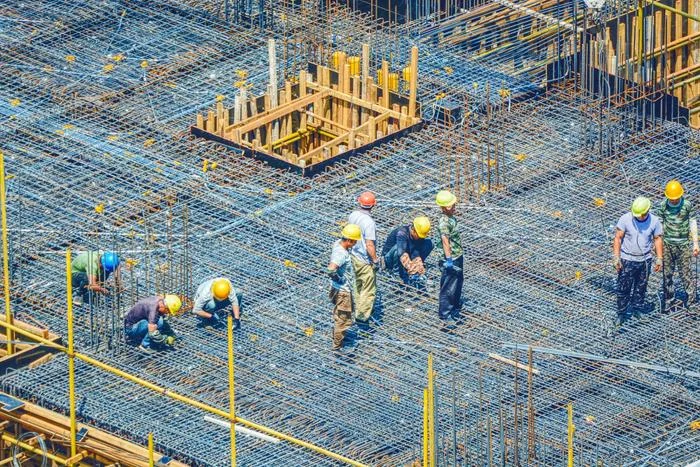
Here are some suggestions to help you keep your hands safe on the construction site:
1. Wear appropriate work gloves for construction:
- Choose different types of gloves for different jobs, such as cut-resistant gloves, vibration-resistant gloves, and insulated gloves.
- Ensure that the gloves are the right size, neither too tight nor too loose, so as not to affect the dexterity of the hands and blood circulation.
- Regularly check the wear and tear of gloves and replace worn-out gloves in time.
2. Use tools correctly:
- Familiarize yourself with and master the proper use of various hand and power tools, and follow the operating procedures for the tools.
- Check whether the tools are in good condition before use, and repair or replace them in time if they are damaged. o Keep the tools clean, avoid oil and grease, and replace them in time.
- Keep tools clean to avoid oil and debris that may interfere with hand grip and operation. o Follow safety procedures.
3. Follow safety procedures:
- Strictly follow the safety rules and regulations and operating procedures of the construction site and do not work against the rules and regulations.
- Make adequate safety preparations and protective measures before carrying out high-risk operations.
- Pay attention to the surrounding environment to avoid hand injuries from accidental objects.
4. Reasonable handling of heavy objects:
- Learn and master proper heavy lifting techniques and avoid the use of brute force.
- When handling heavy objects, try to use handcarts or other auxiliary tools to reduce the burden on the hands. o Keep the hands steady during the handling process.
- Keep your hands stable during lifting to prevent heavy objects from slipping or hitting your hands.
5. Pay attention to hand hygiene and warmth:
- Wash hands promptly after exposure to hazardous substances to avoid skin irritation or injury from chemicals.
- In cold weather, pay attention to hand warmth to avoid frostbite and poor blood circulation.
- Perform regular hand care, such as applying hand cream, to keep the skin moisturized.
6. Handle hand injuries on time:
- In the event of a hand injury, stop work immediately and seek medical attention.
- For minor cuts or abrasions, clean the wound and bandage it to stop the bleeding. o For serious hand injuries, clean the wound and bandage it to stop the bleeding.
- For serious hand injuries, such as broken bones or broken fingers, the hand should be taken to a hospital immediately for treatment.
In conclusion, construction safety is everyone’s responsibility. On a construction site, don’t let yourself get hurt, and don’t hurt others. Please wear work gloves for construction as a first line of protection.
Thirdly, why should you wear work gloves for construction?
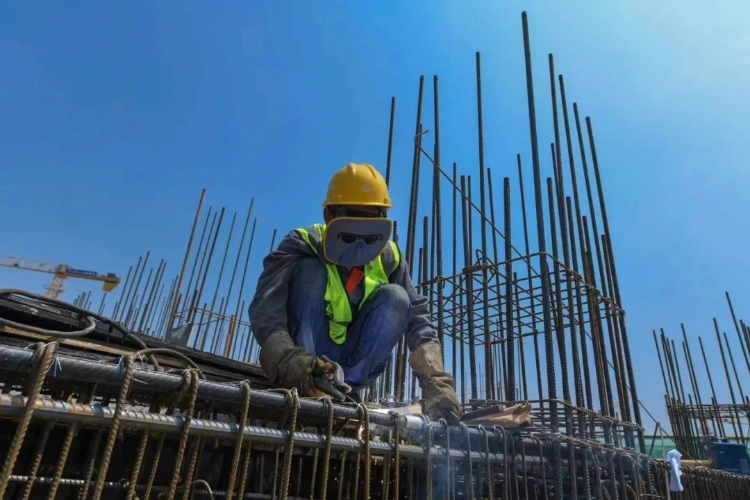
Through the above introduction, perhaps you have a general understanding of why you need to wear work gloves for construction when you are working:
1. Protect your hands from injury: there are many dangerous items and sharp instruments on the construction site, such as nails, rebar, gravel, etc., which may cause injury to the hands. Wearing work gloves for construction can effectively prevent hands from being scratched, punctured, or abraded by these items.
2. Chemical resistance, abrasion resistance, oil resistance: in some specific working environments, such as contact with chemicals, paint, or oil, work gloves for construction can provide the necessary protection to prevent these harmful substances from direct contact with the skin, to avoid causing allergies, corrosion or poisoning and other hazards.
3. Cold protection and warmth: when working in cold environments, work gloves for construction can play a role in keeping hands warm and preventing frostbite due to prolonged exposure to low temperatures.
4. Improve work efficiency and safety: the design of work gloves for construction usually takes into account the comfort and dexterity of the hand, so that workers in the case of wearing gloves are still able to operate tools and materials freely and improve work efficiency. At the same time, gloves can also increase hand friction and reduce the risk of hand slippage, thus improving work safety.
Therefore, wearing work gloves for construction is essential to keep your hands safe and improve your work efficiency and safety. You should also choose gloves that suit your work needs and wear and use them correctly to ensure their protective effect.
Fourth, what are the precautions for wearing work gloves on a construction site?

On construction sites, you need to pay attention to the following matters when wearing work gloves for construction:
1. Choose suitable gloves: Choose suitable work gloves for construction according to the nature of the work and the environment, such as anti-cutting gloves, anti-vibration gloves, insulated gloves, and so on. At the same time, make sure that the gloves are the right size, neither too tight nor too loose, so as not to affect the dexterity of the hand and blood circulation.
2. Check the integrity of the gloves: Before putting on the gloves, check whether there are any breakages, wear, and tear, or holes in the gloves, and if there are, they should be replaced in time to ensure the protective effect of the gloves.
3. Put on the gloves correctly: Stretch the work gloves from the palm upwards until the hand and wrist are completely covered, and make sure that the gloves fit snugly on the hand and do not slip off easily.
4. Pay attention to the cleaning and maintenance of gloves: Work Gloves for construction will be contaminated with dust, dirt, and other debris during the use of gloves, they should be cleaned and maintained regularly to prolong the service life of the gloves and to maintain their protective performance.
5. Timely replacement of gloves: Gloves should be replaced promptly after prolonged use or damage to ensure continuous hand protection.
6. Avoid sharing gloves: Different people have different sizes and shapes of hands. Sharing gloves may cause them to break or reduce their protective effect, and may also spread pathogens such as bacteria or viruses.
In addition, the following points should be noted:
1. when using power tools or operating machinery, special care should be taken not to entangle work gloves in the machinery to avoid danger.
2. for work that requires contact with chemical substances, gloves with appropriate protective properties should be selected and relevant safety practices should be followed.
3. when handling sharp objects or hot objects, special care should be taken so that the gloves are not punctured or burned.
In short, when wearing work gloves for construction, you need to pay attention to such matters as choosing the right gloves, checking the integrity of the gloves, wearing gloves correctly, paying attention to the cleaning and maintenance of the gloves, replacing the gloves in time, and avoiding sharing gloves, to ensure the safety and health of your hands.
Fifth, a few of the best work gloves for construction are recommended.

In the construction industry, no one work glove can be universally recognized as the “best” because different types of work and operating environments require different types of gloves to provide proper protection. Each type of glove has its unique design and features to meet specific needs.
EVERPRO SAFETY, a supplier of work gloves from China, specializes in providing a full range of hand protection solutions for construction workers and industry practitioners. With advanced production technology, strict quality control, and an in-depth understanding of the industry’s needs, EVERPRO SAFETY designs and produces a wide range of efficient, durable, and comfortable work gloves for construction.
Therefore, construction workers need to choose the right gloves for their work environment, rather than the “best” gloves.
EVERPRO SAFETY offers a wide range of work gloves for construction to meet the needs of different types of work and working environments in the construction industry:
1. Anti-vibration gloves: using the latest anti-vibration technology and materials, such as gel pads or foam liners, effectively reduces the impact of vibration tools on the hands. Particularly suitable for jobs that use vibrating equipment, such as concrete workers, drillers, etc.
2. Anti-impact gloves: TPR impact-absorbing material is added to the back of the hand and finger area to protect the hand from accidental collision. Suitable for carrying heavy objects, operating machinery, or working in high-risk areas, such as porters, machinery operators, steel workers, tile workers, etc..
3. Cut-resistant Gloves: Made of high-strength fibers such as Kevlar or Dyneema, HPPE, provide excellent protection against cuts and are suitable for handling sharp materials or carrying out delicate work, such as stonemasons, carpenters, metalworkers, etc.
4. Chemical Resistant Gloves: made of special materials such as Nitrile or Vinyl Chloride, they can resist a wide range of chemicals and protect the hands from chemical damage. Suitable for concrete workers, chemical operations, paint construction, and other types of work.
5. Abrasion-resistant gloves: Nitrile or latex material can be chosen as the common type of gloves, which not only have good abrasion resistance but also have relatively low cost. It is suitable for jobs working on rough surfaces or in high-friction environments, such as cleaners, general laborers, and so on.
Each EVERPRO SAFETY work glove is carefully designed to combine ergonomics and comfort materials to ensure comfort and dexterity under prolonged wear. Meanwhile, the detailed design of non-slip texture, breathable fabric, and reinforced knuckles further enhance the practicality and user experience of the work gloves for construction.


